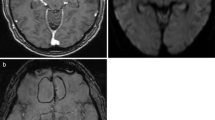Abstract
Background
Accurate assessment of treatment response in children with intracranial pus collections is vital to guide appropriate therapy and reduce morbidity and mortality.
Objective
To correlate serial MR-measurable changes in diffusion-weighted imaging (DWI) with clinical response to treatment.
Materials and methods
We retrospectively reviewed clinical notes, conventional MR sequences and DWI in eight children with intracranial pus collections. Trace DWI signal intensity and apparent diffusion coefficient (ADC) values were compared at three time points: at initial diagnosis (eight children, 13 collections), at follow-up during continued clinical infection (three children, sp collections), and at follow-up when clinical infection had resolved (seven children, 12 collections).
Results
At initial diagnosis all patients were septic and collections showed restricted diffusion (mean ADC 0.61±0.15×10−3mm2/s). Patients with persistent clinical sepsis at follow-up DWI had collections with persistent low ADC values (0.66±0.21×10−3mm2/s), significantly (P<0.001) below normal cortical gray matter values. Successful resolution of the infection was associated with a significant rise in ADC values (1.57±0.57×10−3mm2/s, P<0.01) compared both to patients with signs of continued sepsis and to normal gray matter values.
Conclusion
Persistent restricted diffusion in pus collections correlates with continued sepsis. Treatment response is associated with clinical resolution of sepsis and ADC value elevation significantly above normal gray matter values.



Similar content being viewed by others
References
Kao PT, Tseng HK, Liu CP et al (2003) Brain abscess: clinical analysis of 53 cases. J Microbiol Immunol Infect 36:129–136
Nadal Desbarats L, Herlidou S, de Marco G et al (2003) Differential MRI diagnosis between brain abscesses and necrotic or cystic brain tumors using the apparent diffusion coefficient and normalized diffusion-weighted images. Magn Reson Imaging 21:645–650
Mikami T, Saito K, Kato T et al (2002) Detection and characterization of the evolution of cerebral abscesses with diffusion-weighted magnetic resonance imaging—two case reports. Neurol Med Chir (Tokyo) 42:86–90
Cartes-Zumelzu FW, Stavrou I, Castillo M et al (2004) Diffusion-weighted imaging in the assessment of brain abscesses therapy. AJNR 25:1310–1317
Ciurea AV, Stoica F, Vasilescu G et al (1999) Neurosurgical management of brain abscesses in children. Childs Nerv Syst 15:309–317
Tsuchiya K, Osawa A, Katase S et al (2003) Diffusion-weighted MRI of subdural and epidural empyemas. Neuroradiology 45:220–223
Wong AM, Zimmerman RA, Simon EM et al (2004) Diffusion-weighted MR imaging of subdural empyemas in children. Am J Neuroradiol 25:1016–1021
Silvera S, Oppenheim C, Touze E et al (2005) Spontaneous intracerebral hematoma on diffusion-weighted images: influence of T2-shine-through and T2-blackout effects. Am J Neuroradiol 26:236–241
Kagawa R, Okada Y, Shima T et al (1999) Neuroimaging findings of the development and resolution of solitary brainstem abscess: characteristics of neuroimagings in the early stage of brainstem abscess and importance of surgical management for brainstem abscess—case report. Neurol Med Chir (Tokyo) 39:621–624
Holz AJ (2005) Conventional T1-weighted imaging in the diagnosis and assessment of brain abscesses. Am J Neuroradiol 26:1298-1300; author reply 1300–1301
Pezzullo JA, Tung GA, Mudigonda S et al (2003) Diffusion-weighted MR imaging of pyogenic ventriculitis. AJR 180:71–75
Stadnik TW, Chaskis C, Michotte A et al (2001) Diffusion-weighted MR imaging of intracerebral masses: comparison with conventional MR imaging and histologic findings. Am J Neuroradiol 22:969–976
Kotsenas AL, Roth TC, Manness WK et al (1999) Abnormal diffusion-weighted MRI in medulloblastoma: does it reflect small cell histology? Pediatr Radiol 29:524–526
Tung GA, Evangelista P, Rogg JM et al (2001) Diffusion-weighted MR imaging of rim-enhancing brain masses: is markedly decreased water diffusion specific for brain abscess? AJR 177:709–712
Hartmann M, Jansen O, Heiland S et al (2001) Restricted diffusion within ring enhancement is not pathognomonic for brain abscess. Am J Neuroradiol 22:1738–1742
Mori H, Abe O, Aoki S et al (2002) Hemorrhagic brain metastases with high signal intensity on diffusion-weighted MR images. A case report. Acta Radiol 43:563–566
Gaviani P, Schwartz RB, Hedley-Whyte ET et al (2005) Diffusion-weighted imaging of fungal cerebral infection. Am J Neuroradiol 26:1115–1121
Batra A, Tripathi RP (2004) Diffusion-weighted magnetic resonance imaging and magnetic resonance spectroscopy in the evaluation of focal cerebral tubercular lesions. Acta Radiol 45:679–688
Guo AC, Provenzale JM, Cruz LC Jr et al (2001) Cerebral abscesses: investigation using apparent diffusion coefficient maps. Neuroradiology 43:370–374
Kim YJ, Chang KH, Song IC et al (1998) Brain abscess and necrotic or cystic brain tumor: discrimination with signal intensity on diffusion-weighted MR imaging. AJR 171:1487–1490
Helenius J, Soinne L, Perkio J et al (2002) Diffusion-weighted MR imaging in normal human brains in various age groups. Am J Neuroradiol 23:194–199
Forbes KP, Pipe JG, Bird CR (2002) Changes in brain water diffusion during the 1st year of life. Radiology 222:405–409
Ketelslegers E, Duprez T, Ghariani S et al (2000) Time dependence of serial diffusion-weighted imaging features in a case of pyogenic brain abscess. J Comput Assist Tomogr 24:478–481
Duprez TP, Cosnard G, Hernalsteen D (2005) Diffusion-weighted monitoring of conservatively treated pyogenic brain abscesses: a marker for antibacterial treatment efficacy. Am J Neuroradiol 26:1296-1298; author reply 1300–1301
Author information
Authors and Affiliations
Corresponding author
Rights and permissions
About this article
Cite this article
Fanning, N.F., Laffan, E.E. & Shroff, M.M. Serial diffusion-weighted MRI correlates with clinical course and treatment response in children with intracranial pus collections. Pediatr Radiol 36, 26–37 (2006). https://doi.org/10.1007/s00247-005-0019-8
Received:
Revised:
Accepted:
Published:
Issue Date:
DOI: https://doi.org/10.1007/s00247-005-0019-8




